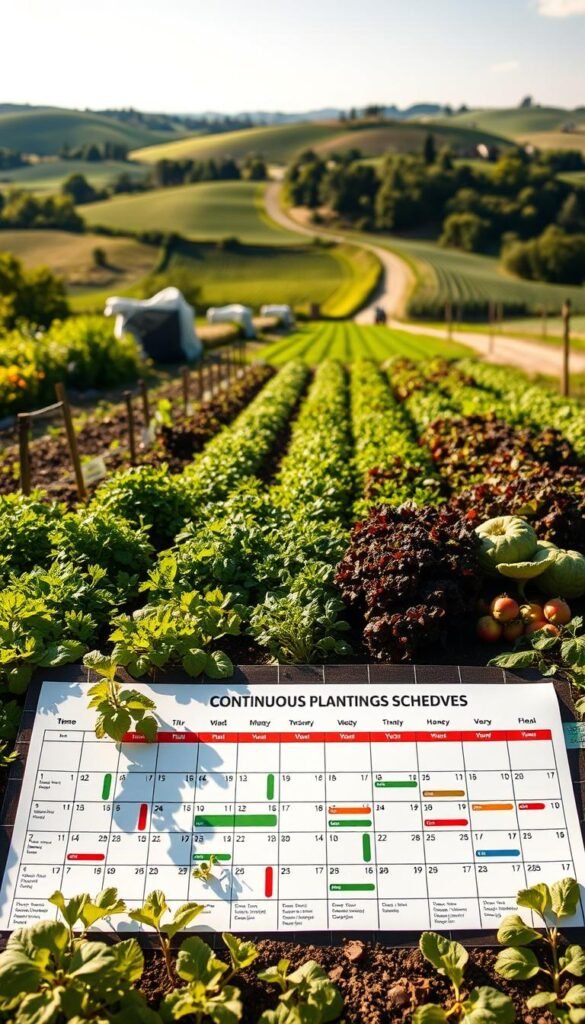Imagine stepping into your backyard every month to gather fresh carrots, crisp lettuce, or juicy bush beans. With thoughtful crop rotations and strategic timing, your garden can become a non-stop source of nourishment. This guide unlocks the secrets of continuous harvests, whether you’re tending a small raised bed or sprawling backyard plot.
By staggering plantings every few weeks, you’ll maximize space and extend growing seasons. For example, quick-growing radishes can be replaced with heat-tolerant cilantro in summer, followed by frost-resistant spinach in fall. Even seasonal care adjustments like using shade cloth during heatwaves help delicate greens thrive.
You’ll discover how legumes like bush beans enrich soil while providing multiple yields. Direct seeding fast-growing varieties ensures a steady supply without overcrowding. We’ll explore practical examples—like sowing carrot seeds alongside leafy greens—to help you avoid wasted space and resources.
Timing is everything. Learn when to start seeds indoors for autumn crops or how cool-season plants can overlap with summer favorites. With simple techniques tailored to your climate, turning your garden into a year-round pantry becomes effortless.
Understanding Succession Planting Basics
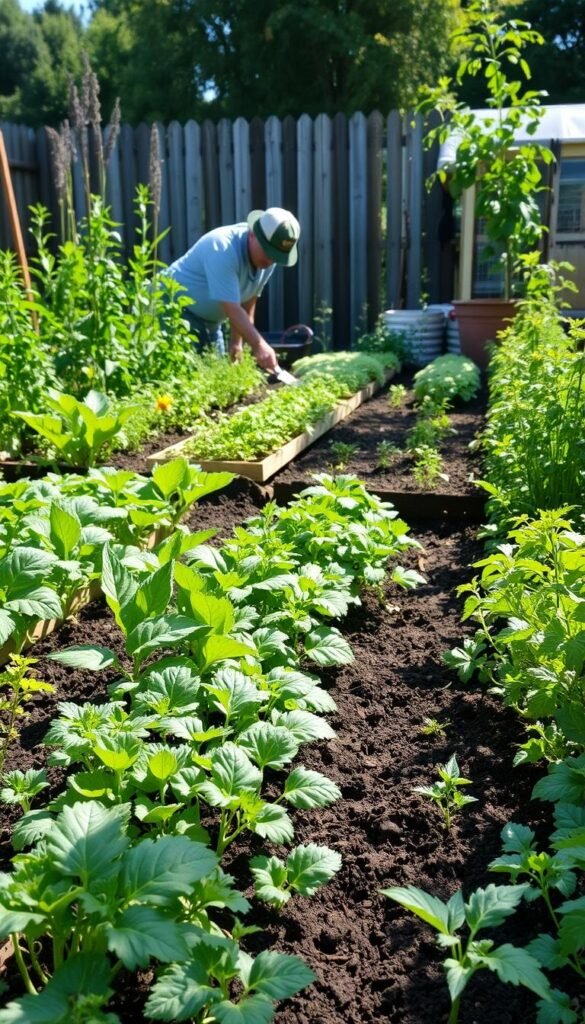
Why settle for one harvest when your soil can yield more? Succession planting means growing crops in intervals rather than all at once. Instead of emptying beds after a single harvest, you’ll replant them quickly to keep your garden productive for months. This method works whether you’re growing leafy greens or root vegetables—and it’s simpler than you think.
What Makes Succession Planting Work?
By staggering crops every 2-3 weeks, you avoid feast-or-famine cycles. For example, sowing lettuce seeds every other Tuesday ensures a steady supply instead of a single glut. Rotating fast-growing radishes with slower carrots maximizes space while improving soil health. According to a succession planting guide, this approach can boost yields by up to 50% in small areas.
| Aspect | Traditional Planting | Succession Planting |
|---|---|---|
| Harvest Duration | 4-6 weeks | 3-6 months |
| Space Usage | Single crop per bed | Multiple crops per bed |
| Workload | Seasonal peaks | Balanced tasks |
Stretching Your Growing Season
Timing matters most. Start cool-weather peas in early spring, then switch to heat-loving basil as temperatures rise. Pairing square foot gardening methods with succession plans lets you grow 3-4 crops per bed annually. Even in colder zones, frost-tolerant kale can thrive after summer tomatoes fade.
You’ll waste fewer plants and enjoy fresher meals. Instead of pulling up entire rows, harvest outer leaves or young roots first. This leaves room for new seeds to sprout while older crops finish maturing.
Garden Planning and Timing Strategies
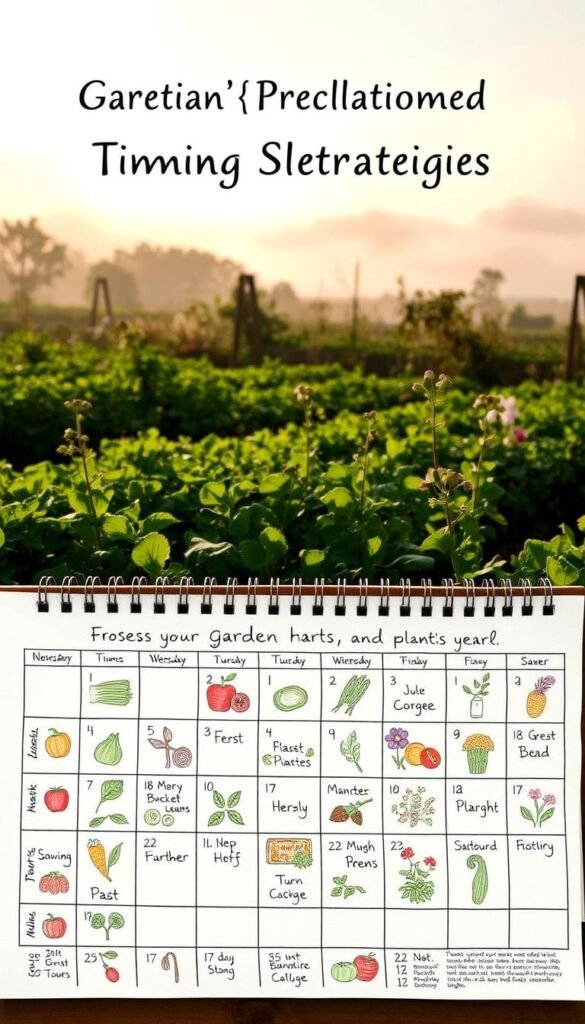
Timing transforms good gardens into year-round powerhouses. Knowing your local frost dates and shoulder seasons—those transitional weeks between weather extremes—lets you squeeze every productive day from your plot. Start by checking your USDA hardiness zone or using online tools to pinpoint average last spring and first fall frosts.
Determining Frost Dates and Shoulder Seasons
In Montana’s Zone 4, for example, the growing season might be just 90 days. Gardeners there plant frost-hardy peas 4-6 weeks before the last spring frost, then switch to quick-maturing bush beans. Low tunnels or row covers add 2-3 weeks to both ends of the season, protecting tender greens like spinach.
Calculate your available time by subtracting crop maturity days from your frost window. If kale needs 60 days and your first fall frost is October 15, sow seeds by August 15. Overlap plantings by rotating crops every 14-21 days to maintain soil nutrients.
Syncing Sowing and Harvest Timelines
Pair early radishes (25 days) with slower carrots (70 days) in the same bed. As you pull radishes, carrot seedlings get room to grow. Warm your soil in spring with black plastic mulch for heat-loving tomatoes, then replant the space with fall broccoli after harvest.
Track sowing dates on a calendar app. In Colorado’s dry climate, stagger drought-tolerant Swiss chard every 3 weeks to avoid summer bolting. Succession isn’t just about planting—it’s aligning lifecycles with nature’s rhythm for nonstop abundance.
How to Plan a Succession Planting Schedule for Year-Round Harvests
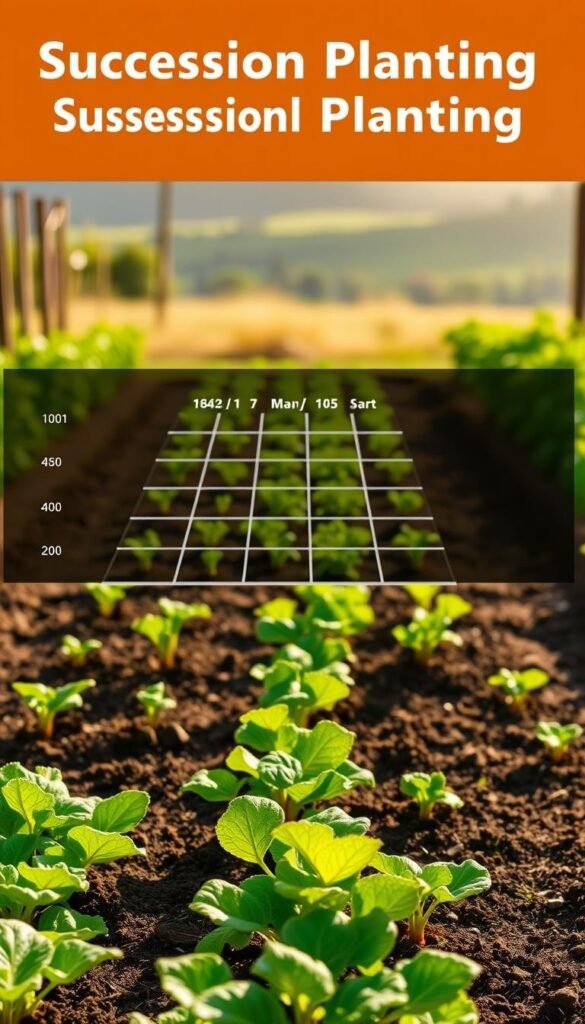
Transform your garden into a perpetual food factory with strategic scheduling. Start by dividing your space into numbered beds—this lets you track rotations efficiently. Assign each bed a planting timeline based on crop maturity dates and seasonal shifts.
Step-by-Step Scheduling for Continuous Growth
Map out three key phases: spring cool crops, summer heat-lovers, and fall/winter hardy varieties. For a 4-bed system, stagger sowings every 14 days. When radishes finish in Bed 1, immediately sow bush beans—their nitrogen-fixing roots enrich soil for the next crop.
| Focus | Traditional Scheduling | Succession Method |
|---|---|---|
| Planting Frequency | Once per season | Every 2-3 weeks |
| Bed Usage | Single crop cycle | 3+ crop cycles |
| Harvest Gaps | 4-8 weeks | 7-10 days |
Track growth stages using a simple spreadsheet. Note when tomatoes get transplanted (Day 0) and when spinach seeds go into their vacated space (Day 55). In colder zones, use this pattern: peas → zucchini → kale, with 21-day intervals between plantings.
Learn from last year’s notes. If basil bolted too quickly in July, shift its planting window to late August. Adjust timelines by 5-7 days yearly until you nail your microclimate’s sweet spot.
Choosing the Right Crops for Each Season
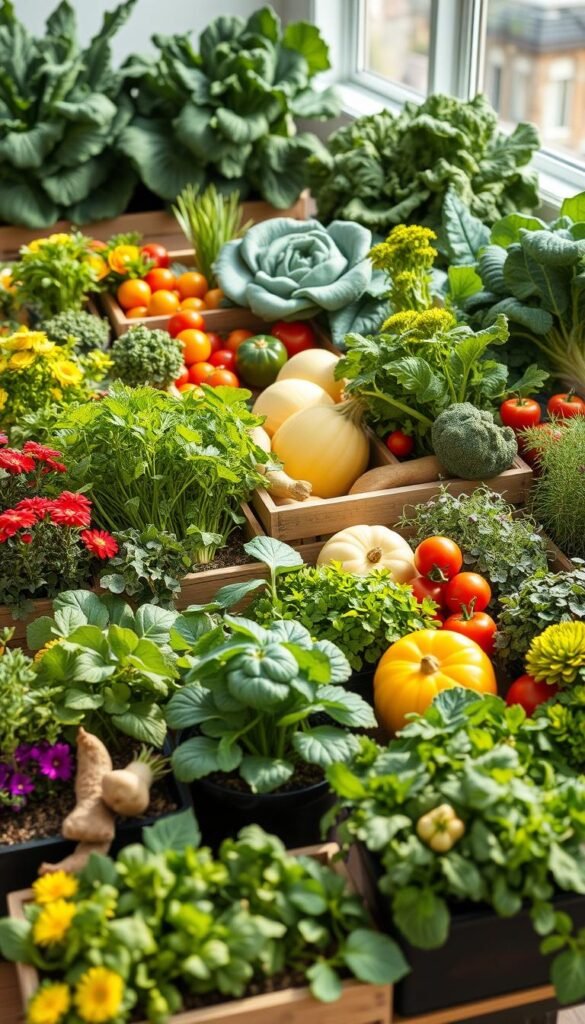
Your garden’s productivity depends on matching crops to nature’s rhythms. Cool springs and fiery summers demand different plant partners. Let’s explore how to pick winners for every weather window.
Selecting Quick-Maturing and Frost-Tolerant Varieties
Beat the clock with fast growers. Radishes like ‘Cherry Belle’ mature in 22 days – perfect for squeezing between spring peas and summer beans. For frosty shoulders, try ‘Winterbor’ kale that sweetens after light freezes.
Check seed packets for these magic numbers:
| Crop | Days to Harvest | Cold Tolerance |
|---|---|---|
| Nantes Carrot | 65 | Moderate |
| Scarle Kale | 50 | High |
| Bush Bean | 48 | Low |
Pair early broccoli with late spinach. When summer heat wilts lettuce, switch to Malabar spinach that thrives in humidity. Your garden becomes a relay race where plants pass the baton seamlessly.
Incorporating Companion Planting and Crop Rotation
Good neighbors make great harvests. Grow tall corn with shade-loving spinach underneath. After harvesting garlic (a natural pest deterrent), plant disease-prone tomatoes in that enriched soil.
Try this 3-year rotation plan:
- Year 1: Beans → Lettuce → Radish
- Year 2: Tomatoes → Spinach → Carrots
- Year 3: Squash → Kale → Peas
Marigolds between cabbage rows deter cabbage moths. Basil near peppers improves flavor while repelling aphids. These partnerships create a thriving gardening ecosystem where every plant plays multiple roles.
Succession Planting Techniques and Tips from the Pros
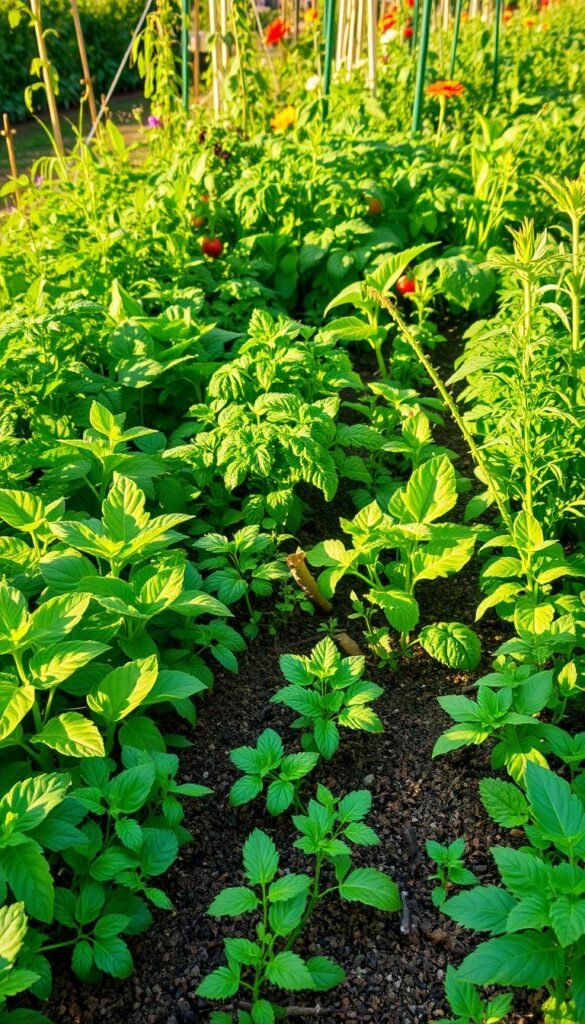
Professional growers have mastered the art of keeping their fields productive through clever timing. Let’s uncover their favorite strategies for maintaining crops in constant motion—no magic required, just smart planning.
Staggered Planting Versus Relay Planting Explained
Staggered planting means sowing the same crop every 2-3 weeks. This works wonders for lettuce or radishes that mature quickly. Relay planting involves overlapping crops—like starting carrots between rows of peas that’ll be harvested first. Flower farms often use relay methods to maintain color displays without empty gaps.
| Method | Best For | Example |
|---|---|---|
| Staggered | Single crop varieties | Bush beans every 14 days |
| Relay | Mixed crop rotations | Spinach under tomato plants |
Expert Tips for Direct Seeding and Pot Starting
Direct seeding saves time for root vegetables like carrots—they dislike transplanting. For heat-sensitive plants like broccoli, start seeds indoors 6 weeks before transplanting. Commercial growers often use plug trays to protect young seedlings from harsh weather.
Try these pro-approved tricks:
- Use biodegradable pots for peas to avoid root disturbance
- Pre-soak beet seeds overnight for faster germination
- Create afternoon shade for lettuce using taller corn plants
Adjust your sowing times based on last year’s notes. If your fall kale struggled, try starting it 10 days earlier this year. Small tweaks create big results in your gardening journey!
Maximizing Garden Space and Improving Soil Health
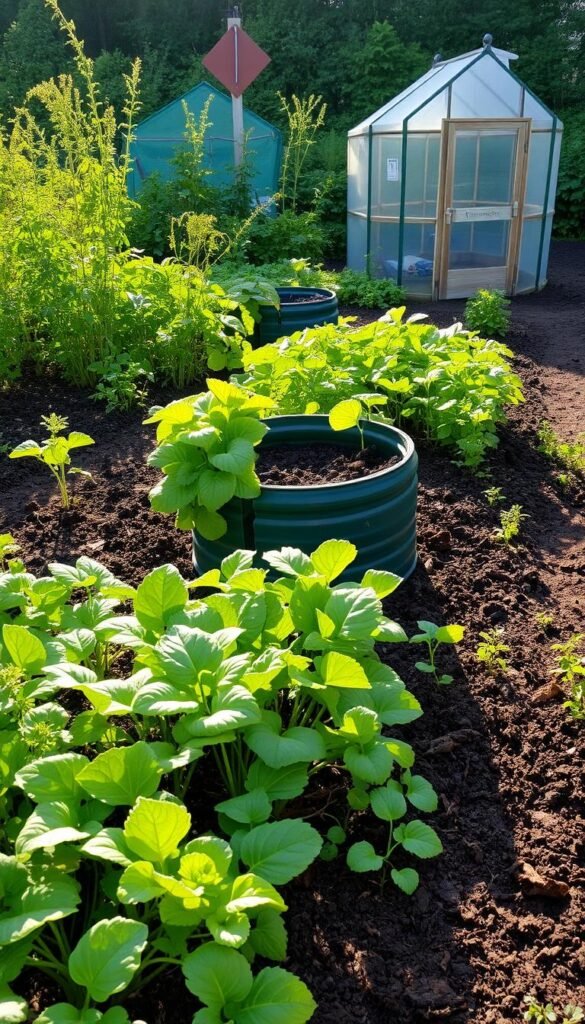
Your garden’s layout acts as the blueprint for endless bounty. Smart designs paired with healthy soil let you grow more in less area while keeping nutrients flowing. Let’s explore how to arrange beds strategically and feed your earth for lasting vitality.
Optimal Garden Bed Layouts and Space Management
Divide growing areas into zones based on sunlight and crop needs. For example, position tall plants like pole beans on the north side to avoid shading shorter greens. Use vertical trellises for cucumbers—this frees up ground space for radishes or herbs.
Try these space-saving tactics:
- Plant fast-growing arugula between slower Brussels sprouts
- Use hexagonal spacing patterns to fit 15% more plants
- Rotate crops clockwise through four quadrants every 3 weeks
| Bed Size | Spring Crop | Summer Crop | Fall Crop |
|---|---|---|---|
| 4×4 ft | Spinach (16 plants) | Bush beans (9 plants) | Kale (12 plants) |
| 4×8 ft | Peas (32 plants) | Zucchini (3 plants) | Carrots (48 plants) |
Using Mulch and Cover Crops for Soil Enrichment
Healthy earth grows better food. After harvesting summer tomatoes, sow winter rye to prevent erosion. Clover planted between crops adds nitrogen—no fertilizer needed. In dry regions, straw mulch keeps soil moist and cool during heatwaves.
Budget-friendly pro tips:
- Chop fallen leaves for free autumn mulch
- Mix buckwheat into empty beds—it suppresses weeds in 10 days
- Top-dress beds with compost tea before each planting
Track maturity dates on a wall calendar. When garlic finishes in July, immediately sow quick-turn mustard greens. Your garden becomes a self-renewing system where every inch works overtime.
Monitoring Growth and Adjusting Your Planting Schedule
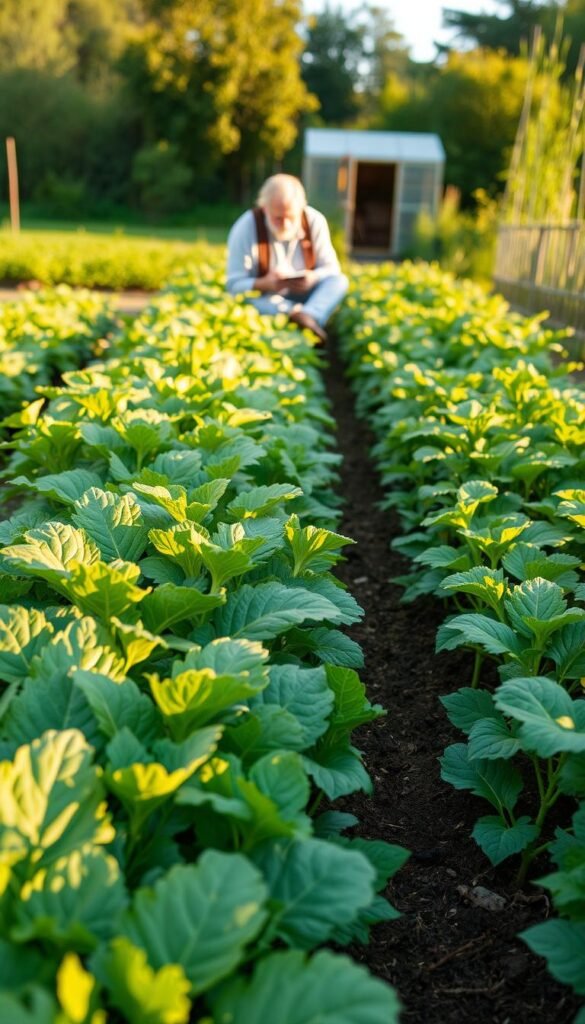
Your garden’s success depends on watching and responding to its daily changes. Regular checks help spot delays or surprises early, letting you tweak timelines before issues escalate. Think of it as a dance with nature—sometimes you lead, sometimes you follow.
Tracking Plant Maturity and Harvest Times
Keep a simple notebook or digital spreadsheet to log key dates. Note when seeds sprout, when flowers form, and when fruits reach full size. For example, if your peas took 55 days instead of the packet’s 50-day estimate, adjust next year’s planting by that gap.
Try these tracking tools:
- Color-coded garden maps showing crop stages
- Weather apps with frost alerts
- Weekly photos to compare growth rates
| Method | Data Tracked | Adjustment Example |
|---|---|---|
| Seed Log | Sowing dates | Start fall kale 1 week earlier |
| Harvest Diary | Yield per plant | Add compost to low-producing beds |
How to Adapt to Changing Weather Conditions
Unexpected heatwaves or early frosts demand quick action. Cover tender greens with row covers if temps drop suddenly. Swap bolting lettuce for heat-loving okra during prolonged summer droughts.
Watch these signals:
- Soil temperature shifts (use a $10 probe)
- Extended rain forecasts delaying seed sowing
- Insect activity indicating stressed crops
If spring stays chilly, delay warm-weather planting by 5-7 days. Keep backup seeds for quick replanting if storms wipe out seedlings. Every season teaches new lessons—embrace the flexibility!
Harvesting the Benefits: Wrapping Up Your Succession Planting Journey
Your garden’s story doesn’t end with the first frost—it evolves. Celebrate your harvest triumphs while eyeing next year’s potential. Tuck away leftover seeds in airtight jars labeled with planting dates, ready to spark life when spring whispers again.
Reflect on what thrived. Did staggered lettuce sowings outpace pests? Did soil enriched by peas boost autumn carrots? Jot down these wins and note where weather threw curveballs. A gardener’s journal becomes your best ally for refining rotations.
Preserve surplus yields through freezing or fermenting. Those extra bush beans? Pickle them as tangy snacks for snowy days. Rotate crop families in beds to prevent nutrient depletion—swap nitrogen-loving corn for root vegetables next season.
Real success lies in the cycle. One Montana grower now harvests spinach through December using low tunnels after summer squash. Another in Texas swaps bolting cilantro for heat-tolerant okra every 21 days. Your shovel becomes a pencil, rewriting next year’s edible story with wisdom from seasons past.

